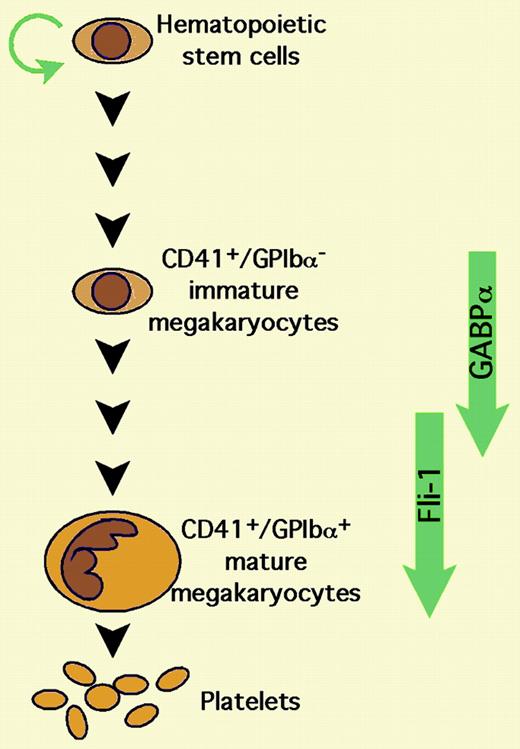Comment on Pang et al, page 2198
Whereas early studies identified different Ets transcription factors1-3as regulators of megakaryocyte gene expression, a recent report highlights the importance of an Ets member for stage-specific gene regulation during megakaryopoiesis.
Friend leukemia integration 1 (Fli-1), a member of the Ets family of transcription factors, plays a central role in megakaryocyte gene expression and megakaryopoiesis, as evidenced by activation of gene promoters such as cMpl, glycoprotein (GP) IX, and GPIIb. Interestingly, megakaryocytes derived from Fli-1 knockout mice display immature morphology, and the level of the late gene GPIX is greatly reduced, but the expression level of early megakaryocytic genes, including αIIb and cMpl, is quite normal.4,5 Building upon this finding, Pang and colleagues astutely rationalize that other Ets factors might play a role in the control of lineage-specific gene activation during early megakaryopoiesis. In this thorough study the authors identified a widely expressed factor, the hetrodimeric GA-binding protein (GABP), as a regulator of early megakaryocyte gene expression. As reviewed by Pang et al, this Ets family member has also been described as regulating genes in the myeloid and lymphoid lineages. As to megakaryocytes, Pang and colleagues used elecromobility shift assays as well as chromatin immunoprecipitation to show that GABPα binds to the αIIb and cMpl promoters, but less to late-expressing gene promoters such as that of GPIX. In contrast, Fli-1 binds preferably to late megakaryocyte-specific genes. In accordance, the ratio of GABPα/Fli-1 drops during maturation of mouse fetal liver megakaryocytes (see the figure).FIG1
In order to further examine the relevance of the new findings to megakaryocyte development, expression level of different genes was determined in fetal liver megakaryocytes derived from GABPα knockdown or control littermates. In accordance with transcription factor binding data, which demonstrated preferential binding of GABPα to early genes, GABPα knockdown megakaryocytes displayed reduced levels of genes associated with early megakaryocyte development, including cMpl and αIIb, with no significant effect on the expression of the late genes, GPIbα, GPIX, or platelet factor 4 (PF4). Finally, the authors also demonstrated that similar to Fli-1, GABPα affects the synergy between GATA and its partner FOG (friend of GATA) during the regulation of early megakaryocytic genes.
This study points to the importance of relative dosages of transcription factors of the same family in regulating genes during megakaryocyte development. Although the authors found a decrease in the ratio of GABPα/Fli-1 during megakaryocyte maturation, some level of each factor is still detected at each stage, and it is not clear why GABP and Fli-1 bind preferentially in vitro (and in vivo) to different cis-acting elements in the different genes. Future studies will examine the role of flanking sequences and/or other binding proteins in determining promoter-specific activation by GABPα or Fli-1. Also, the mechanism by which GABPα and Fli-1 bestow transcriptional synergy on GATA-1 and FOG-1 is still to be explored. ▪


